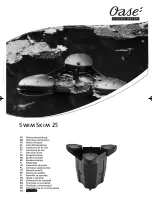
8
5. What To Do In The Case Of Breakdowns?
Problem
Possible Cause
Remedy
Pump doesn't attain final pressure
• Pump dirty
• Clean the pump
• Operating fluid dirty
• Operate pump for a longer period with open gas
ballast valve or change operating fluid
• Leak in system
• Repair leak
Unusual operating noises
• Silencer dirty
• Clean the silencer (see Service Instructions).
• Pump system damage
• Request repair by PFEIFFER Service
Pump doesn't start
• Mains power missing
• Check mains voltage and motor switch
• Ambient temperature <12 °C
• Warm up pump
• Dirty pump stages
• Request cleaning by PFEIFFER Service
• Damaged pump system
• Request repair by PFEIFFER Service
6. Maintenance
When carrying out servicing work, take the following
precautions:
Always ensure the pump cannot be switched
on when carrying out any work on the pump. If
necessary, remove the pump from the system to
carry out inspection work.
➡
Only dismantle the pump as far as is necessary in order to
repair defects.
➡
Dispose of used operating fluid in compliance with local
regulations.
➡
When working with synthetic operating media, toxic
substances and substances contaminated with corrosive
gases, the relevant instructions governing their use must
be observed.
➡
Only use benzine or similar agents for cleaning pump
parts. Do not use soluble cleaning agents.
6.1. Replacing The Operating Fluid
The rate of deterioration of the operating fluid depends on the
pump applications.
➡
The level of deterioration of organic operating fluids (for
example P3) can be read off from the colour scale in
accordance with DIN 51578 on the supplementary sheet
PK 800 219 BN/B, on request.
– The colour scale enables precise colour determination.
➡
Fill a specimen in a test tube or some similar vessel and
test by holding against the light.
➡
Where the discolouration is dark yellow to red brown
(equivalent to 4 ... 5 on the scale) change operating fluid.
Where organic operating fluids, for example P3,
are involved, the operating fluid should be
changed at least once a year!
Replacing The Operating Fluid
➡
Switch off the pump.
➡
Unscrew operating fluid drain screw 4 and drain operating
fluid.
The operating fluid temperature can be as high
as 80 °C. During maintenance and repair work,
process related toxic gases and vapours can
escape from the operating fluid which may
become contaminated with harmful substances
(radioactive, chemical etc.).
Disposal of used operating fluid is subject to the relevant
regulations.
➡
Screw in operating fluid drain screw 4.
➡
Allow pump to run for about 10 seconds with open vacuum
flange.
➡
Drain off remaining operating fluid.
➡
In the case of serious contamination, the operating fluid
will have to be changed several times.
➡
Screw in operating fluid drain screw 4 with O-ring 49.
➡
Fill in fresh operating fluid and check level as per
section 4.1.
Operating fluid can contain substances from
the medium pumped. Operating fluid must be
disposed of in accordance with the local
respective regulations.
Please request safety instruction data sheets for operating
fluids from PFEIFFER or download from the INTRANET/
INTERNET.
Any other repairs may only be carried out by qualified personnel in conjunction with the service instructions.


































